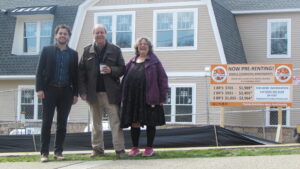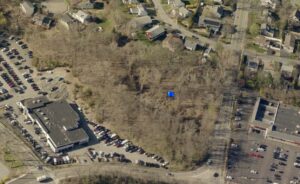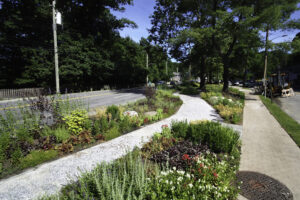
“Affordable housing” in Westchester is in the eye of the beholder.
To a billionaire hedge-fund manager, the 5,800-square-foot home on Rockgate Farm Road in Bedford Corners — asking price $40,000 a month — is “affordable.”
The four-bedroom, five-bath house features a large pool surrounded by an outdoor kitchen, a Finnish sauna, and a covered patio. The bluestone back patio wraps around the house and overlooks four acres of land.
For a family of five in Mount Vernon, struggling to pay the monthly food bill and keep the kids in new clothes and smartphones, the reality of their life is that goods and services in Westchester cost 57% more here than in the rest of the U.S. With an average annual rental cost of about $30,000 (or $2,500 a month), Westchester is “unaffordable” for households making less than $100,000 a year.
A Westchester County Housing Needs Assessment report completed five years ago outlined conditions that have only worsened since. The report stated that county-wide there were 846 homeless families, 4,523 severely overburdened households, and another 11,703 new housing units that were needed to keep up with demand.
More people still want to live in Westchester than there are homes to house them, and the laws of supply and demand dictate that housing costs will remain high. But there are some ways to bring improvement.

The people who build homes in Westchester believe that attacking the high cost of building here is one approach to lowering the cost of housing.
Business Council of Westchester’s (BCW) Smart Development Working Group, which consists of 17 developers, conducted an in-depth study comparing the development costs of multi-family housing projects in the pre-pandemic era with today’s reality.
“Every year it seems as if new regulations add costs and sometimes remove revenues from our projects,” Mark Weingarten, a partner at DelBello Donnellan Weingarten Wise & Wiederkehr and Co-Chair of the Smart Development Working Group, said in a statement. “Various levels of government keep increasing the cost of these projects to developers. I am afraid we are reaching a breaking point.”
The Smart Development Working Group’s analysis found that, in Yonkers, a 240-unit, 300,000-square-foot building completed in 2023 had a per-unit hard cost increase of 47 percent, a 106 percent increase in insurance costs, and a 55 percent financing cost increase over a 370-unit, 450,000-square-foot building in a similar location that was completed in 2019. The result is that the cost of a 2024 residential complex is the same as a 2019 structure that is 50 percent larger.
In White Plains, the analysis found that, compared to a 300-unit, 364,000-square-foot multi-family project built in 2020, a 200-unit, 235,000-square-foot project erected in 2023 saw a 54 percent per-unit increase in hard costs; a 93 percent increase in per-unit insurance costs and a 57 percent increase in per-unit financing costs.
Weingarten noted that throughout Westchester County, thousands of apartments are approved for construction, but the sites remain inactive due to rising interest rates on borrowing and the rising cost of building materials.
Weingarten attributed some of Westchester’s housing crisis to …
- The State Environmental Quality Review Act, which allows development opponents to make project approvals lengthy, expensive and uncertain.
- A lack of infrastructure to support multifamily projects, particularly north of I-287.
- Opposition to developments that draw school-age children.
- Increases in fees for affordable housing and recreation funds.
- Outdated parking requirements that can add millions of dollars in unnecessary costs.
- Elimination of the State and Local Tax Deduction (SALT).
- Elimination of lower condominium taxation in some municipalities.
- Restrictions on some energy sources and green energy requirements that add significant costs.
- Efforts to limit the effectiveness of industrial development agencies.
- Demands by organized labor to increase wages beyond market rates.
In spite of these challenges, and a scarcity of land to develop, creative solutions are producing results.
“All of society is recognizing that there is a shortage of housing especially affordable,” said Nance Shatzkin, President of the non-profit Croton Housing Network. “That has made communities, including Croton, more receptive to doing projects like Maple Commons.”
Located at the intersection of Municipal Place and Maple Street, Maple Commons has targeted a June 2024 opening, following nearly four years of efforts — by a combination of a private, for-profit builder, government at all levels, and a local community non-profit — to bring 32 new apartments to market that will give families a chance to live affordably.
Determining who gets to live in affordable housing is driven by a formula usually pegging the maximum annual income level at $117,440, which is 80% of the average median income (AMI). Most communities require that 10% of apartments are set aside as affordable.
The Village of Croton-on-Hudson and Maple Commons developer Regan Development Corp. agreed to set aside all the units as affordable. To give lower-income families access, some units are set aside at 30%, 50% and 60% of AMI as well. That means a family of four with an income of $44,040 is eligible. The three-bedroom monthly rent at 80% is $2,964 and at 30% is $1,055.
“There are people in the community who work that need affordable housing,” said Jeremy Regan, the firm’s Development Coordinator. “Some have just graduated college, others are elderly, looking to downsize. For us, it’s important that we offer different income levels the opportunity from the 30% to the 80% AMI range.”
Coordinating the work among several government layers and the developer required a concerted effort from the Village. Deputy Mayor Len Simon believes Maple Commons is an important step in the Village’s efforts to expand housing opportunities for current residents and new arrivals.
“We view this as workforce housing — there’ll be lots of folks in Croton right now that will apply — the only thing is that many of them can’t afford to stay overnight,” Simon said. ‘They’re working in Shoprite, they’re teachers, they’re nurses, they’re technicians, they’ll be one of our first responders.”
Maple Commons makes economic sense because of the various funding sources that Regan Development arranged through state, federal and county funds. The $18 million project will generate tax credits that investors will buy, and Regan will continue to own and manage the property. The Village sold the property to Regan and agreed to reduced property taxes through PILOT (payment in lieu of taxes). Another 63 new apartment units in three other projects are in development in Croton that would produce six more affordable apartments.
“The community and Village officials have given us overwhelming support throughout this process,” Regan said. “We find that if communities want to build housing and they welcome it, the process is a lot easier. We look to build in communities that want us and Len [Simon] has been a cheerleader and a bulldozer for us.”
The Croton Housing Network has developed some affordable housing in the Village dating back to the 1980s. For Nance Shatzkin, Maple Commons is a dream fulfilled with a tinge of jealousy thrown in.
“The only thing I have against the Regans is that in this one project they are creating more units of housing than I have been able to create in the Village over 35 years,” she said.
The deadline to submit an application to Maple Commons in Croton is April 18, with the lottery drawing on May 3 at 2 pm on Zoom. Visit regandevelopment.com/new-york-new-jersey-real-estate-developers/maple-commons-apartments.
Jim Roberts is a veteran journalist who resides in Peekskill.






